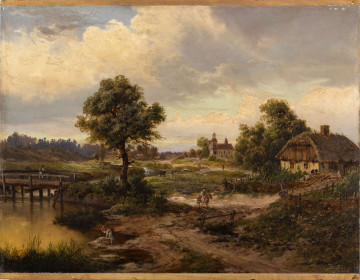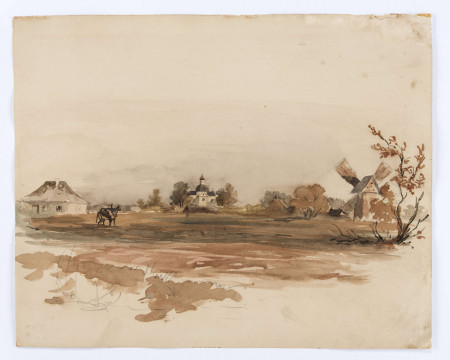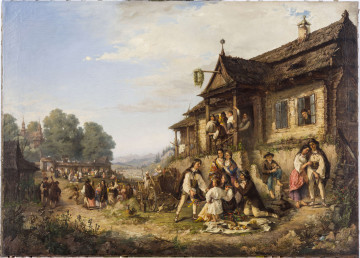
Landscape with a small church
1897
National Museum in Lublin
Part of the collection: Landscape
For the budding Polish painters of the second half of the 19th century, the Mecca of art was Munich, where they went in large numbers to study. Born in 1873, near Grodno, Stanisław Żukowski studied at the Moscow School of Painting, Sculpture and Architecture. His masters were the classics of Russian landscape painting – Isaac Levitan, Abram Archipov, and Archip Kunji. Apart from Żukowski, Ruszczyc and Krzyżanowski (educated in Petersburg) also adopted and creatively developed the Russian concept of landscape, considered one of the most interesting artistic formulas in Europe at the turn of the century. It was based on the local tradition, the art of the primitives, and on colour and texture explorations similar in form to early Impressionism.
After graduation Żukowski, stayed in Russia. He exhibited with the Mir Iskusstwo and Pieriedwiżnicy groups, which promoted academic, realistic, thematically patriotic and nationalistic painting. At that time, the painter signed his works in Cyrillic letters. In 1923, he fled post-revolutionary Bolshevik Russia and settled in Warsaw, where he ran a private painting school. He died in 1944 in the German camp in Pruszków.
Żukowski was an excellent landscape painter. He also painted interiors and occasionally portraits. He approached his subjects realistically, using an interesting technique of leaving brush strokes, which gave his paintings a seemingly careless finish. An essential value of his paintings is colouring, ideally selected colour consonance. The painter willingly depicted changes and phenomena occurring in nature in subsequent seasons of the year.
The composition Wylew jeziora [Overflow of the Lake] shows a peaceful view of a Russian settlement during the overflow of a river. The work draws attention to the harmony and richness of two colours, grey and white. A few patches of green subtly enliven the cool tonality. The spaces of sky and earth, close to each other in colour, are separated by a line of buildings. The horizontally arranged planes are broken by the only vertical element, i.e., the towers of the Orthodox church rising above the even line of houses. This parallelism of distant planes highlights and intensifies the enormity of the depicted phenomenon. With its foamy surface undulating with the slanting furrows of the waves, the river reaches the nearest houses. The power of the element contrasts with the silence of the deserted town.
Bożena Kasperowicz
Author / creator
Dimensions
cały obiekt: height: 60,6 cm, width: 37 cm
Object type
painting
Technique
oil technique
Material
canvas, oil-based paint
Creation time / dating
Creation / finding place
Owner
The National Museum in Lublin
Identification number
Location / status

1897
National Museum in Lublin

1853
National Museum in Lublin

1870
National Museum in Lublin
DISCOVER this TOPIC
Castle Museum in Łańcut
DISCOVER this PATH
Educational path